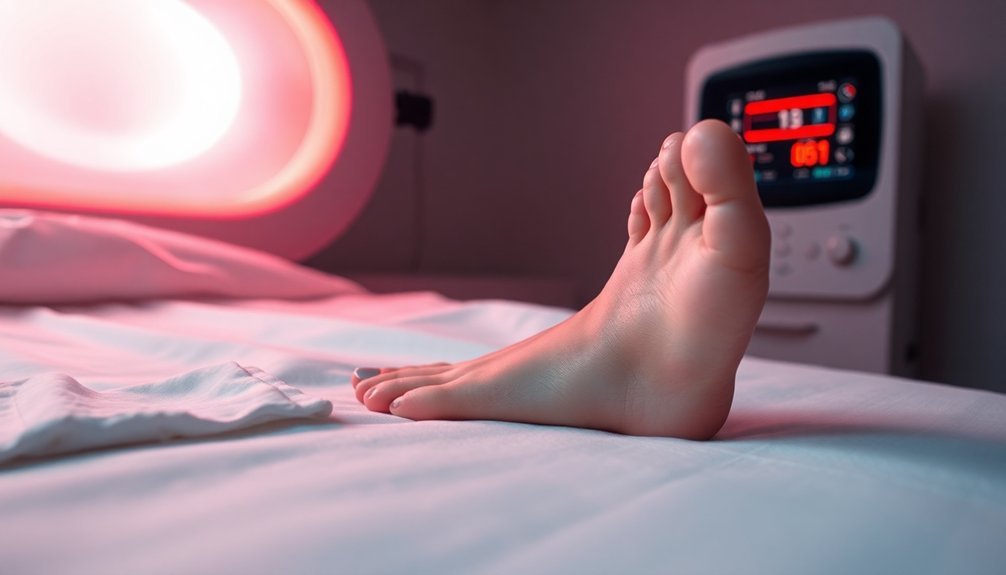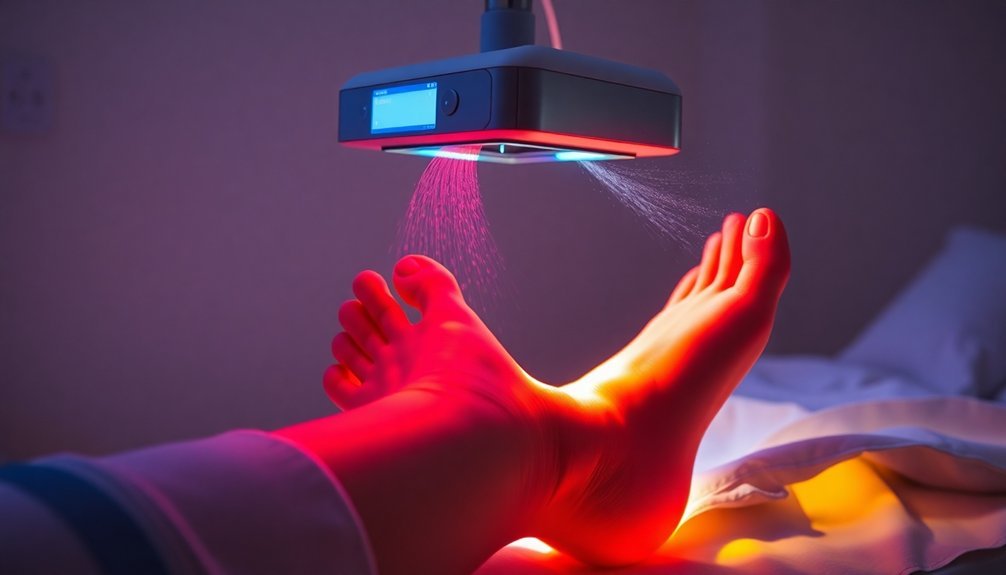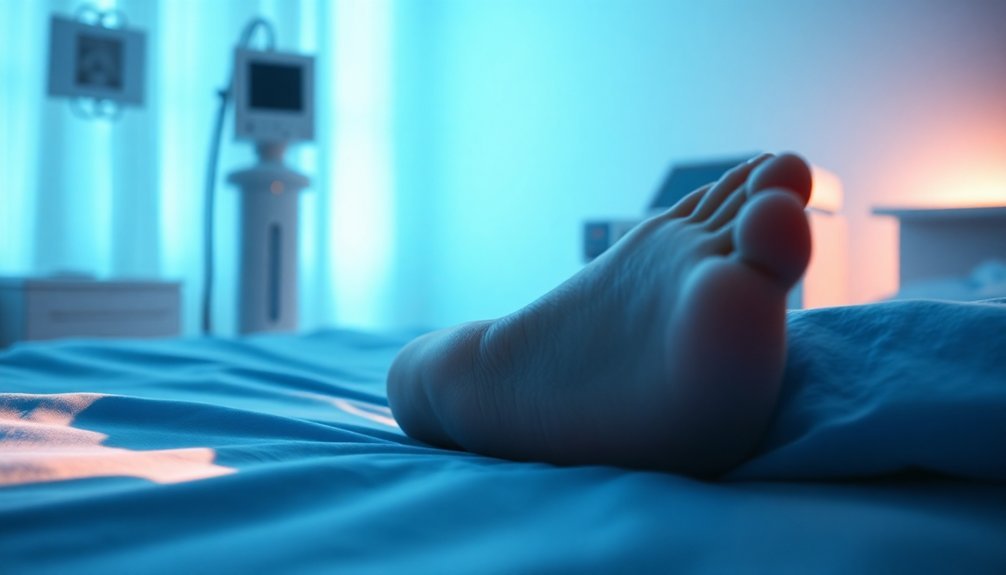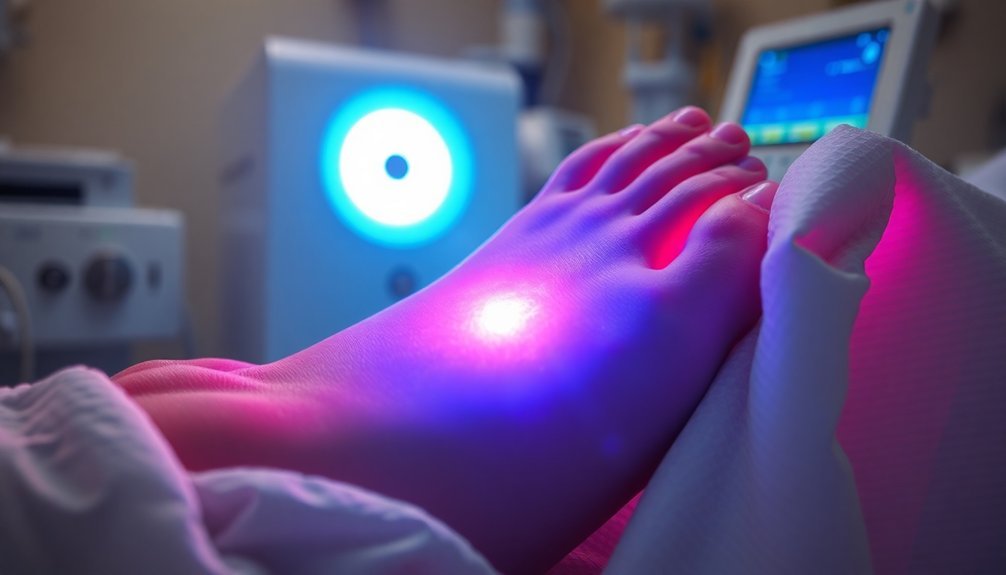Near-infrared therapy is a game-changer for diabetic wound healing. You can start by using wavelengths like 660 nm, 808 nm, and 830 nm, applied at lower power densities of about 0.1 W/cm². Aim for a fluence of 2.35 to 5 J/cm² and treat wounds three times a week. Weekly evaluations can also help you measure tissue oxygenation and adjust the care plan as needed. With this approach, many diabetic wounds may heal in just 21 days, considerably quicker than conventional methods. You're on the verge of discovering even more effective strategies to enhance healing outcomes.
Overview of Near-Infrared Therapy

Near-infrared therapy is a cutting-edge treatment that utilizes specific wavelengths of light to penetrate deep into tissues, reaching up to 5mm beneath the skin. This light is absorbed by photo acceptor molecules such as hemoglobin, myoglobin, and cytochrome c oxidase, stimulating cellular energy metabolism and boosting ATP production through mitochondrial enzyme changes.
You'll find that this therapy not only increases the production of nitric oxide but also enhances your overall health and energy levels. Notably, near-infrared light can be absorbed by muscles, joints, and bone, further enhancing its therapeutic effects.
The clinical applications of near-infrared therapy are impressive. It aids in wound healing, including difficult diabetic wounds, by promoting faster recovery and reducing inflammation. You can experience effective pain relief and decreased stiffness from conditions like rheumatoid arthritis.
Additionally, after exercise, it can help improve muscle recovery and mitigate damage. This therapy even supports recovery in neurological conditions, making strides in areas such as traumatic brain injuries.
Furthermore, it's a non-invasive, painless treatment with no known side effects, making it safe for patients with serious conditions. The portable nature of the technology allows for treatment at various locations, increasing accessibility for everyone.
NIRS for Healing Prediction
Regularly integrating near-infrared spectroscopy (NIRS) into clinical practice has transformed how healthcare providers predict the healing of diabetic foot ulcers.
With a positive predictive value of 91% for healing within four weeks, NIRS markedly outperforms traditional methods, which typically fall below 60%. The technique's high sensitivity of 0.9 and specificity of 0.86 provide you with reliable insights into wound healing progress.
DNIRS operates by using 70-MHz modulated light to measure oxy- and deoxy-hemoglobin concentrations in the wound bed.
By evaluating these changes weekly or bi-weekly, you can gain a clearer understanding of tissue oxygenation saturation (StO2), essential for wound closure. This approach allows you to detect different tissue oxygenation patterns that correlate with clinical appearance, aiding in the prediction of healing. Additionally, early indicators of wound healing can be identified through NIRS measurements, enhancing your ability to tailor interventions effectively.
Moreover, utilizing NIRS not only streamlines your treatment plan but can also save over $12,600 per patient by identifying ineffective therapies early on.
The technique empowers clinicians like you to make informed decisions based on actual physiological conditions, ultimately boosting patient outcomes while optimizing resource allocation.
Photobiomodulation Parameters

Understanding the parameters of photobiomodulation (PBMT) is essential for optimizing the healing of diabetic wounds. The effectiveness of PBMT largely depends on the wavelength used. Near-infrared (NIR) light, particularly in the range of 600-1100 nm, penetrates deeper into tissues compared to visible red light, enhancing its therapeutic effects. Specifically, wavelengths like 660 nm, 808 nm, and 830 nm have shown considerable improvements in wound healing.
Power density is another critical aspect. Lower power densities, such as 0.1 W/cm², often facilitate better healing than higher densities, which can inhibit wound contraction and collagen synthesis. It's important to find the right balance in energy absorption by the cellular tissues.
Fluence and energy also play an important role. Recommended fluences of 2.35 to 5 J/cm², typically administered three times a week, impact the healing response. Treatment timing and duration must be consistent, tailoring exposure times (e.g., 50 s, 25 s, or 17 s) to suit different power densities.
Properly adjusting these parameters can greatly enhance healing throughout various phases of wound recovery. Additionally, PBM promotes extracellular matrix production, which is vital for maintaining structural integrity and accelerating healing processes.
Clinical Benefits of PBM
Numerous clinical studies have demonstrated the impressive benefits of photobiomodulation (PBM) therapy for diabetic wounds.
You'll find that PBM leads to notable improvements in healing outcomes, making it a powerful option for managing these challenging conditions.
- Accelerated Tissue Regeneration: PBM promotes angiogenesis and enhances collagen synthesis, which is essential for effective healing.
- Reduced Inflammation and Pain: By decreasing pro-inflammatory cytokines, PBM minimizes pain and edema, enhancing patient comfort.
- Enhanced Cell Migration: PBM considerably increases the rate of fibroblast migration and proliferation, vital for wound closure, especially in hyperglycemic conditions.
- Faster Healing Times: Treated diabetic wounds can heal in as little as 21 days, compared to 40–60 days for untreated ones, demonstrating PBM's efficacy.
These benefits not only lead to quicker closure of wounds but also enhance the overall quality of the tissue formed.
The evidence clearly shows that incorporating PBM therapy into your wound care strategy can considerably improve healing outcomes for diabetic patients.
Integrated Wound Care Approaches

Integrated wound care approaches bring a multifaceted strategy to managing diabetic wounds, enhancing healing outcomes through collaboration and innovative techniques. By integrating surgical treatments, telemedicine, and multidisciplinary teamwork, you can greatly improve the care and recovery of patients with diabetic foot ulcers.
Here's a visual representation of these integrated approaches:
| Aspect | Key Components | Benefits |
|---|---|---|
| Surgical Treatment | ISWT, TTT technique, VSD, skin grafting | Faster healing, fewer amputations |
| Telemedicine | Continuous monitoring, easy access to specialists | Early intervention, improved patient confidence |
| Multidisciplinary Team | Collaboration between specialists in surgery, research, and nursing | thorough care, standardized protocols |
| Diagnostic Techniques | Near-infrared spectroscopy, biomarker research | Enhanced healing predictions, tailored therapies |
Frequently Asked Questions
What Are the Side Effects of Near-Infrared Therapy?
Near-infrared therapy can lead to skin irritation, headaches, and insomnia. You might experience redness or blistering, especially with improper use. Always consult your healthcare provider regarding medications that could heighten these side effects before treatment.
How Long Does Each Session of Therapy Last?
Each therapy session lasts anywhere from a few minutes to over 30 minutes, depending on the type of treatment. You can adjust the duration based on your comfort and the specific condition being addressed.
Can Near-Infrared Therapy Be Used for Other Conditions?
Yes, near-infrared therapy's versatile. You can use it for musculoskeletal injuries, neurological conditions, and even promoting overall tissue health. It relieves pain, enhances recovery, and improves metabolic functions across various health concerns effectively.
How Is Patient Progress Monitored During Treatment?
You monitor patient progress through regular assessments, tracking changes in hemoglobin concentration and wound size. Utilizing smartphone apps for documentation and real-time imagery helps you adjust treatment plans and encourages ongoing patient engagement throughout the healing process.
What Qualifications Should Practitioners Have for Administering This Therapy?
To administer this therapy, you should have a relevant medical degree, complete specialized courses, gain clinical experience, and obtain certifications. Staying updated with continuing education and understanding safety precautions is essential for effective treatment.
In Summary
Incorporating near-infrared therapy into your wound care routine can considerably enhance healing for diabetic wounds. By understanding the protocols and parameters of photobiomodulation, you can predict healing outcomes and achieve clinical benefits. Remember, an integrated approach that includes this therapy can lead to better results for patients. Don't underestimate the power of combining advanced techniques with traditional care methods to optimize recovery and improve quality of life for those dealing with diabetes-related wounds.





Leave a Reply